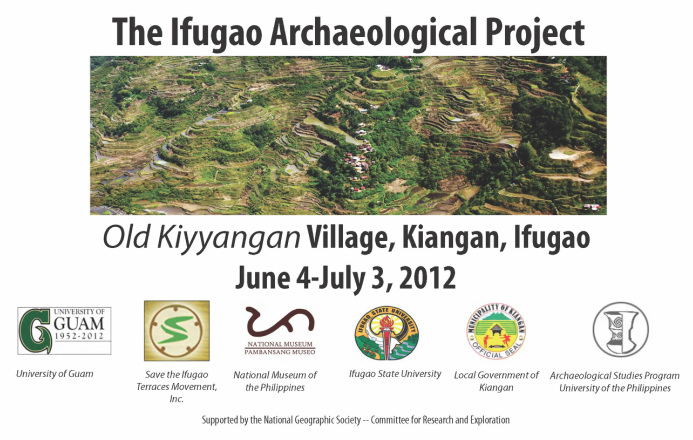|
The first field season of the Ifugao Archaeological Project will be launched June 6, 2012 at the Old Kiyyangan Village, Kiangan, Ifugao. The IAP will also run the 2012 UOG Ifugao Archaeological Field School, in collaboration with the Save the Ifugao Terraces Movement, Inc., National Museum of the Philippines, Ifugao State University, University of the Philippines, and the Kiangan Local Government Unit.
This year's investigations will focus on the Old Kiyyangan Village, the putative first Ifugao village according to Ifugao mythology. The area is located, about four (4) kilometers from Kiangan Poblacion. There are different versions of this origin myth, Barton (1955) records one story that appeared in his The Mythology of the Ifugaos. The myth recorded by Barton was provided by Pumihic Pablo, a mumbaki (Ifugao religious practitioner) of the Puitan District and was confirmed by two other mumbaki from Bo-oh (present-day Bocos) village in Banaue, Tabayag and Pahitte. As the site is believed to be one of the oldest in the area, our excavations hope to provide radiocarbon dates that will contribute to the culture history and chronology of the region. Rober Maher did some excavations in the site during the early 1980s, but his dates were inconclusive. With advances in technology and the practice of chronometric hygiene, we are hoping to establish baseline information to the development of Cordillera terrace-building tradition. Overall, the Ifugao Archaeological Project hopes to contribute to Ifugao scholarship and to the development of sustainable conservation plans for the rice terraces. The Ifugao Rice Terraces illustrate humanity’s relationship with the environment. The complexity of Ifugao agricultural and irrigation systems, however, is still poorly understood. Building on my previous and ongoing work among the Ifugao, this project examines anthropological issues that include relationship between agricultural and irrigation systems with emergent complexity; pathways to intensification; and organizational entailments of irrigation systems. Such work informs on theoretical foundations of studies of agricultural systems and social organization by applying the model of self organizing systems, providing empirical data to similar studies in island Southeast Asia and elsewhere (the Andes, Spain), and provides an historical ecological approach in the study of emergent complexity. This study will add a new perspective in the recursive relationship between humans and their landscape. This year's field school features participants from the University of Guam (Charmaine Ledesma, Jacy Moore, Mariana Sanders, Joffrey Martinez, Vanessa Cabrera); University of Toronto (Jay Allen Villapando); SUNY-Oneonta (Maddie Yakal); UCLA (Ellen Hsieh); University of British Columbia (Narae Lee); UC-Riverside (Mikhail Echavarri); University of the Philippines-Archaeological Studies Program (Marie Sioco, Mindy Ceron, Kate Tantuico); and, University of Hawaii-Luce Asian Archaeology Program (Lun Votey, Mita Muong, both from Cambodia). The field school is directed by Stephen Acabado (University of Guam) and co-directed by Marlon Martin (CEO, SITMo), Ana Labrador (Assistant Director, National Museum), Grace Barretto-Tesoro (University of the Philippines), and John Peterson (University Guam). The IAP is partially supported by a National Geographic Society-Committee for Research and Exploration Grant. We hope to see you there!
3 Comments
10/8/2013 10:52:03 am
I wasn't aware of the many ripples and depth to this story until I surfed here through Yahoo! Excellent job. My kindest regards.
Reply
Leave a Reply. |
Stephen AcabadoI am an anthropological archaeologist interested in human-environment interactions Archives
June 2012
Categories
All
|

 RSS Feed
RSS Feed
